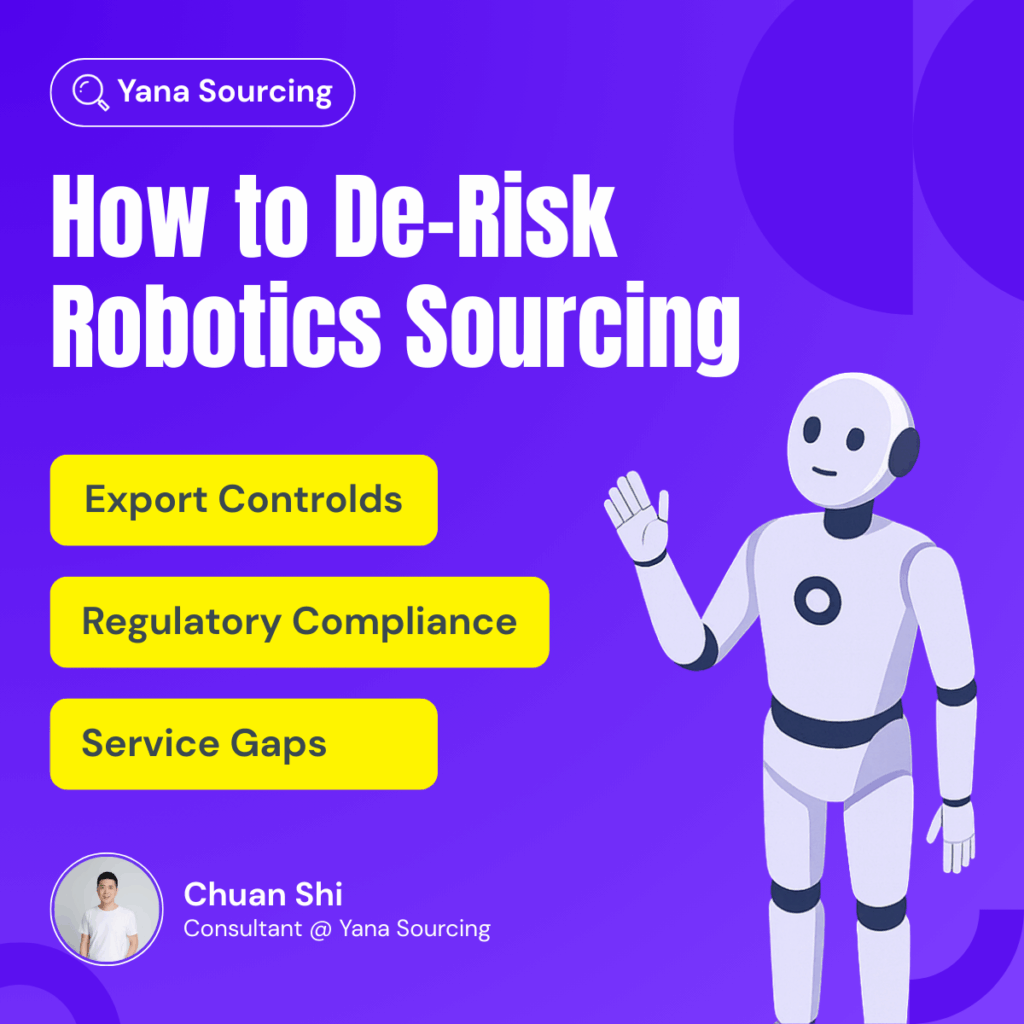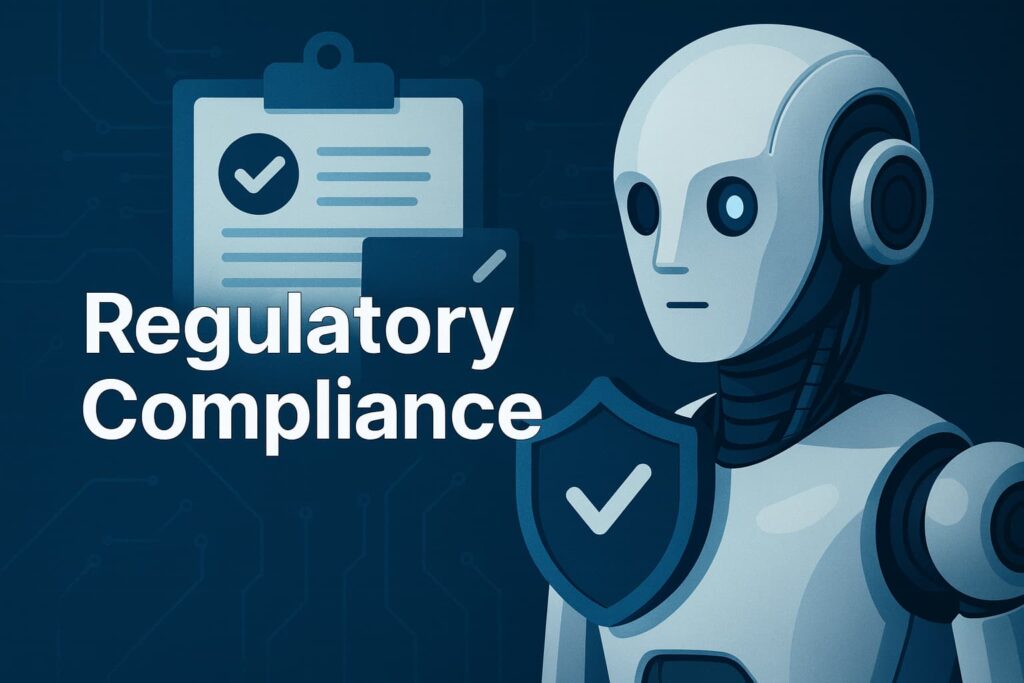Table of Contents
Introduction – understanding why it is so important to de-risk

In the race to automate factories, warehouses and public spaces, companies are increasingly turning to service robots, collaborative arms and even humanoids. Yet along with opportunity comes risk: supply chains can be disrupted, export rules can entangle shipments, safety standards can stall certification, and inadequate after‑sales support can sink deployments. That is why understanding how to de-risk robotics sourcing: export, compliance, and service gaps has become a critical skill for procurement teams in 2025 and beyond. The International Federation of Robotics (IFR) reports that the global market value of industrial robot installations reached US $16.5 billion, and service robots for logistics and hospitality are growing at more than 30 % per yearifr.org. As more industries adopt robots, the hidden risks in sourcing become more visible: a shipment held at customs because of misclassified harmonised system (HS) codes; a humanoid stuck in regulatory limbo because it lacks CE marking; a warehouse fleet crippled due to lack of spare parts. Companies cannot afford to learn these lessons the hard way.
This article offers a world‑class deep dive into how to de‑risk robotics sourcing: export, compliance, and service gaps. It draws on data and insights from the IFR, the World Economic Forum and industry case studies to provide actionable guidance on export controls, regulatory compliance and after‑sales service. The goal is not to create yet another list of generic tips but to map the specific pitfalls and opportunities in the global robotics supply chain. We examine why export licenses may be needed for advanced AI chips and actuators; how different regions, China, Europe and the United States, approach robotics regulation; why quality certifications such as CE, FCC and ISO 13482 matter; and how a right‑to‑repair mindset can turn service gaps into competitive advantages. Throughout the discussion we link the guidance back to the overarching theme: how to de‑risk robotics sourcing: export, compliance, and service gaps.
Export controls – navigating the rules in how to de‑risk

For any organisation wondering how to de‑risk robotics sourcing: export, compliance, and service gaps, the first step is to understand export controls. Robots and their subcomponents often contain technologies that are subject to national security restrictions. High‑performance actuators used in humanoids, AI accelerators used in autonomous navigation, and sensors capable of dual‑use (civilian and military) applications may fall under export control regimes such as the United States’ Export Administration Regulations (EAR), the European Union’s Dual‑Use Regulation or China’s Export Control Law. Failing to obtain the proper licences can result in fines, delays and reputational damage. The World Economic Forum notes that humanoid robots rely on a multi‑industry supply chain that spans semiconductors, AI systems, actuators and sensors. Many of these components are considered “foundational technologies,” which are the focus of recent export‑control reforms in the United States. When planning a sourcing strategy, companies should classify each part according to the relevant Commerce Control List and determine whether an export license is required for the destination market.
Another export consideration in how to de‑risk robotics sourcing: export, compliance, and service gaps involves battery regulations and hazardous materials. Many mobile robots use lithium‑ion batteries, which are subject to International Air Transport Association (IATA) guidelines and UN regulations for dangerous goods. Improper packaging or labelling can cause customs delays or rejection. Packaging must conform to UN 38.3 testing and include the appropriate UN number and hazard labels. Shippers should also prepare Material Safety Data Sheets (MSDS) and test reports. Additionally, customs authorities require accurate HS codes for robots and their parts. Misclassifying a robot as a “toy” rather than as “industrial machinery” can trigger penalties or reclassification. When in doubt, consult with customs brokers and use the World Customs Organization’s (WCO) explanatory notes. An ounce of prevention in export documentation can save weeks of holdup.
Regional dynamics also play a role in how to de‑risk robotics sourcing: export, compliance, and service gaps. China, the world’s largest robot market, has integrated humanoid robots into its national strategy and emphasises creating a scalable supply chain. At the same time, Chinese authorities are tightening controls on the export of advanced chips and high‑end manufacturing equipment. In October 2023 China restricted exports of gallium and germanium used in semiconductors, which could affect some robotics suppliers. Conversely, the United States has implemented restrictions on exporting AI chips to certain countries. Procurement teams should maintain a watchlist of sanctioned entities, restricted destinations and controlled technologies. They should also consider alternative suppliers within permitted jurisdictions to avoid single points of failure in how to de‑risk robotics sourcing: export, compliance, and service gaps.
Finally, physical logistics matter. Export packaging must withstand long transit times while protecting delicate sensors and actuators. Wooden crates for heavy industrial arms require fumigation and certification to meet ISPM 15 standards. Insured shipping is essential: lost or damaged goods can jeopardise project timelines. Smart logistics providers can monitor shipments via IoT devices that track temperature, shock and humidity. Transparent tracking not only reduces risk but can be integrated with supply‑chain management systems. By proactively addressing export controls, shipping requirements and geopolitical risk, companies set a strong foundation for how to de‑risk robotics sourcing: export, compliance, and service gaps.
Regulatory compliance – mastering standards in how to de‑risk

If export rules are the first line of defence, then compliance with safety and electromagnetic standards is the second. To truly understand how to de‑risk robotics sourcing: export, compliance, and service gaps, buyers must be familiar with the regulatory frameworks governing robots in their target markets. In the European Union, robots fall under the Machinery Regulation (replacing the Machinery Directive), the Low Voltage Directive (LVD), the Electromagnetic Compatibility (EMC) Directive and, for service robots interacting with people, the ISO 13482 standard for personal care robots. Achieving the CE mark requires a risk assessment under EN ISO 12100 and compliance with harmonised standards. In the United States, the Federal Communications Commission (FCC) regulates electromagnetic emissions, while OSHA and ANSI/RIA R15.06 (and R15.08 for mobile robots) govern safety. Robots used in medical applications must comply with FDA requirements and ISO 13485 for quality management. Japan and China have similar but distinct frameworks. Understanding these differences helps companies avoid regulatory surprises when pursuing how to de‑risk robotics sourcing: export, compliance, and service gaps.
Regional attitudes towards regulation influence the compliance landscape. The IFR’s position paper on humanoid robots notes that Europe places a strong emphasis on ethical implications and human‑centric design; European businesses focus on safety, efficiency and human collaboration rather than replacing workers. In contrast, China prioritises using humanoids in service sectors and is establishing a scalable domestic supply chain. The United States sees humanoids as tools for logistics and manufacturing. These differences mean that a robot designed for one region may need modifications for another. For example, a collaborative robot sold in Europe may require power‑and‑force limiting features to satisfy EN ISO 10218‑1/2, while the same robot in China might be acceptable with higher speeds and payloads. To achieve success in how to de‑risk robotics sourcing: export, compliance, and service gaps, one should design for the strictest standard among target markets or plan for region‑specific variants.
Certifications also serve as credibility markers in how to de‑risk robotics sourcing: export, compliance, and service gaps. CE, FCC and UL marks signal that a product meets safety and quality requirements, making customs clearance smoother and building trust with customers. Having a third‑party test report from organisations like TÜV Rheinland or UL demonstrates due diligence. On the documentation side, manufacturers must prepare technical files containing risk assessments, schematics, test reports, software declarations and user manuals. For AI‑enabled robots, the forthcoming EU AI Act will require transparency on data sets, AI models and human oversight. The IFR trends report highlights that robots are being improved to become more energy efficient through lightweight construction and advanced gripper technologies. Complying with eco‑design and sustainability directives can further differentiate your offerings. A robust compliance strategy is therefore essential to how to de‑risk robotics sourcing: export, compliance, and service gaps.
Service gaps – closing the loop in how to de‑risk robotics sourcing: export, compliance, and service gaps

Even the most careful exporters and compliant manufacturers will fail if after‑sales support is weak. A key lesson in how to de‑risk robotics sourcing: export, compliance, and service gaps is that the business model extends beyond the sale. Robots are complex electromechanical systems that require routine maintenance, software updates and occasional repairs. A lack of spare parts or repair expertise can lead to downtime that wipes out productivity gains. The IFR’s “Prepare to Repair” article explains that robotics manufacturers must adopt a service‑oriented approach: they need to design for reparability, stock spare parts and build repair capabilities. The article notes that focusing on reliability and longevity reduces the frequency of interventions. It also highlights the importance of local spare‑parts availability; FANUC Europe reported 99.97 % local spare‑parts availability in 2021 and an average repair time of less than 20 hours. Such performance benchmarks illustrate the level of service needed to de‑risk sourcing.
The after‑sales challenge is amplified in new categories like humanoid robots. The IFR warns that industrial manufacturers are focusing on humanoids performing single‑purpose tasks and that it remains uncertain whether humanoids can become an economically viable business case. In practice, early adopters may be left with prototypes that are unsupported if the start‑up dissolves or pivots. To mitigate this risk in how to de‑risk robotics sourcing: export, compliance, and service gaps, buyers should seek suppliers with established service networks and long‑term commitments. Contracts should include service‑level agreements (SLAs) specifying response times, spare‑parts availability, software update schedules and warranty coverage. It is wise to evaluate whether the supplier runs its own robots in production; the IFR article reveals that FANUC tests its robots in its own fully automated factories, gaining firsthand understanding of reliability issues and enabling rapid improvement. Suppliers who “eat their own dog food” will be better prepared to deliver dependable products.
Robots‑as‑a‑Service (RaaS) models present a partial solution to service gaps in how to de‑risk robotics sourcing: export, compliance, and service gaps. Instead of purchasing robots outright, customers pay a monthly fee that includes hardware, software, installation and maintenance. The IFR trends report mentions that RaaS allows enterprises to benefit from automation with no fixed capital involved. RaaS providers often handle maintenance and upgrades, reducing downtime risk. However, RaaS also creates dependency on the provider’s financial health. Companies should examine the provider’s track record, funding and service infrastructure. In addition, companies can build internal capabilities by training technicians, stocking critical spares and using predictive maintenance tools. Digital twin and IoT platforms can monitor robot health and predict failures, allowing proactive repairs. A holistic service strategy is thus essential for success in how to de‑risk robotics sourcing: export, compliance, and service gaps.
Regional comparisons – global perspectives in how to de‑risk robotics sourcing
Effective strategies for how to de‑risk robotics sourcing: export, compliance, and service gaps differ by region. In China, the government has put humanoids at the center of its national strategy, emphasising domestic production and supply chain control. China’s robotics market benefits from dense component clusters in the Yangtze River Delta and the Greater Bay Area. This concentration reduces lead times and lowers costs but can also create geopolitical risk if trade disputes arise. Companies sourcing from China should diversify suppliers across multiple provinces and maintain buffer inventories. Export restrictions and intellectual property concerns must also be managed.
In the United States, the robotics industry is driven by private investment and applications in logistics and manufacturing. American start‑ups like Boston Dynamics and Figure emphasise performance and agility, while Tesla’s humanoid program envisions robots for factories. The U.S. regulatory approach is relatively permissive compared with Europe, focusing on occupational safety (OSHA) and product liability. Export controls are becoming more stringent for AI chips and high‑performance actuators, so companies should consult the Bureau of Industry and Security (BIS) when evaluating how to de‑risk robotics sourcing: export, compliance, and service gaps. Service support in the U.S. often relies on integrators and value‑added resellers, meaning that establishing clear SLAs is critical.
Europe champions human‑centric robotics. The IFR article notes that European companies emphasise collaborative robots that enhance human capabilities and focus on ethical and social considerations. The EU’s AI Act will introduce requirements for transparency, data governance and risk management. The Machinery Regulation and Low Voltage Directive already mandate CE marking for safety and electromagnetic compatibility. Companies operating in Europe must invest in risk assessments, technical documentation and third‑party testing. On the service side, European customers expect high reliability and quick repairs. FANUC’s example of 99.97 % spare‑parts availability and average repair times under 20 hours sets a benchmark for the region. Understanding these expectations helps companies tailor their approach to how to de‑risk robotic sourcing: export, compliance, and service gaps.
Risk mitigation strategies – practical steps in how to de-risk robotics sourcing
Armed with an understanding of export controls, compliance requirements, service gaps and regional nuances, what practical steps can procurement leaders take to master how to de‑risk robotics sourcing: export, compliance, and service gaps? This section distills the lessons into a concrete playbook:
- Map your supply chain. Identify every component, from actuators and sensors to AI chips, and determine its origin, HS code and export control classification. Use this map to spot single points of failure and to plan alternative suppliers. The WEF’s observation that humanoid robots depend on a multi‑industry supply chain underscores the need for multi‑supplier strategies.
- Classify and certify early. Before signing purchase orders, verify that products meet target market regulations. Ask suppliers for CE, FCC and UL certificates. Confirm that risk assessments have been performed and that documentation is available. For AI‑enabled robots, request details on data sets and algorithm transparency. This early diligence prevents compliance problems later in how to de-risk robotics sourcing: export, compliance, and service gaps.
- Negotiate service‑level agreements. Contracts should specify mean time to repair (MTTR), spare‑parts availability, response times and software update commitments. Use benchmarks such as FANUC’s 99.97 % spare‑parts availability and sub‑20‑hour repair times to set expectations. Build escalation clauses that trigger penalties or alternative arrangements if service commitments are missed.
- Adopt a right‑to‑repair mindset. Choose suppliers that design products for ease of repair and support. The IFR article emphasises the importance of reliability and reparability. Request modular designs, accessible components and open documentation. Build internal repair capabilities or partnerships with authorised service centres. This approach reduces downtime and fosters sustainability.
- Plan for geopolitical risk. Diversify suppliers across regions to mitigate trade disruption. Stock strategic spare parts and maintain buffer inventory for critical components. Monitor policy changes in export controls and national strategies, as both the U.S. and China continue to adjust rules affecting AI chips and high‑precision actuators. Align your strategy with your key markets’ philosophies: human‑centric in Europe, efficiency‑driven in China, and productivity‑oriented in the U.S..
- Leverage Robots‑as‑a‑Service wisely. RaaS can reduce upfront costs and provide built‑in maintenance. However, evaluate the provider’s financial stability and service network. Use RaaS for pilot projects or non‑core tasks, and always maintain exit options.
By following these steps, procurement leaders can systematically address how to de‑risk robotics sourcing: export, compliance, and service gaps and position their organisations for long‑term success.
Ethical and social considerations – balancing values in how to de‑risk robotics sourcing
An often overlooked dimension of how to de‑risk robotics sourcing: export, compliance, and service gaps is the ethical and social impact of automation. Robots are increasingly embedded in public spaces, healthcare and homes. The IFR notes that service robots help paraplegics to walk again, reduce the time spent on household chores, make retail experiences more productive, improve the freshness of the food we eat and promote sustainability. These benefits come with responsibilities: robots must respect privacy, avoid bias and operate transparently. Ethical design requires data anonymisation, unbiased training datasets and clear user consent. Regulations like the EU’s General Data Protection Regulation (GDPR) and forthcoming AI frameworks push companies toward privacy‑by‑design. Social acceptance also depends on inclusive design that considers diverse users and minimises job displacement. Engaging stakeholders, employees, customers and regulators, in the deployment process helps identify concerns and design solutions. When sourcing robots, companies should assess whether suppliers adhere to ethical guidelines and whether their products can be updated to meet evolving societal expectations. By integrating ethics into the procurement process, organisations not only reduce reputational risk but also unlock new value from robots that genuinely enhance human well‑being.
Conclusion – mastering how to de‑risk robotics sourcing: export, compliance, and service gaps
Robotics is transforming industries, but progress comes with complexity. Export controls, regulatory compliance and after‑sales service represent the three pillars of risk. This article has shown how understanding export licences, HS codes and logistics requirements lays the groundwork for how to de‑risk robotics sourcing: export, compliance, and service gaps. It has explained how mastering standards such as CE, FCC and ISO 13482 ensures safety and market access, and how recognising regional differences can prevent unpleasant surprises. It has highlighted the importance of building reliability and repairability into products, citing examples from the IFR’s service‑oriented case studies. And it has provided a practical playbook for reducing risk, from supply‑chain mapping to right‑to‑repair practices.
Ultimately, success in robotics depends not on a single technology but on a holistic approach to sourcing. By integrating export diligence, compliance rigour and robust service into their strategies, companies can turn risk into opportunity. The world’s most successful robotics adopters will be those who know how to de-risk robotics sourcing: export, compliance, and service gaps and who partner with suppliers that share a commitment to quality, transparency and customer support. Yana Sourcing stands ready to guide you through this journey with our private list of vetted robotics suppliers, ensuring that your next robot deployment is not just innovative but also compliant, reliable and sustainable.
Related Articles
Part 1: Embodied AI’s DJI Moment: 5 Proven Steps to Source
Part 2: 5 High-Margin Robotics Categories to Source from China in 2025
Part 3: The Hidden Value Chain of Embodied AI: From Actuators to End‑Use
Part 4: How to De-Risk Robotics Sourcing: Export, Compliance, and Service Gaps


Leave a Reply